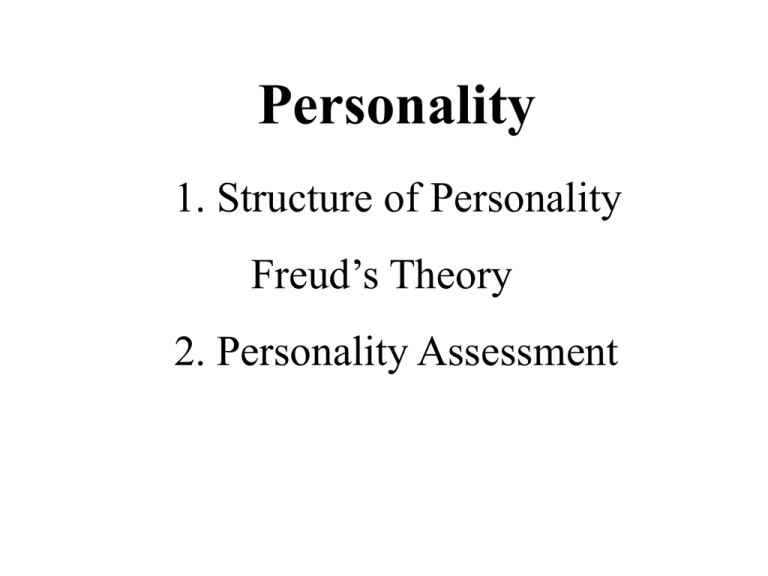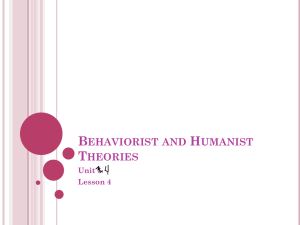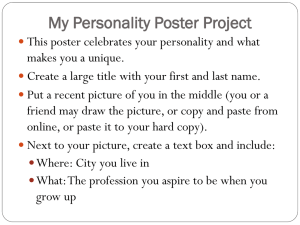
Personality
1. Structure of Personality
Freud’s Theory
2. Personality Assessment
What is Personality?
How people differ at the individual level
Personality
An individual’s characteristic pattern of thinking,
feeling, and acting
The Psychoanalytic Perspective
Freud’s Theory
Unconscious motivations
influence personality
The Psychoanalytic
Perspective
Psychoanalysis - Freud
Theory of personality that attributes our thoughts and
actions to unconscious motives and conflicts
People are motivated by unacceptable passions for sex and
aggression, so we repress those motivations from
consciousness, causing conflict
Techniques used in treating psychological disorders
that seek to expose and interpret unconscious conflicts
The Psychoanalytic
Perspective
Free Association
Dream Interpretation
Jokes
Psychoanalytic Structure of
the Mind
• The mind is divided into 3 parts:
- Conscious mind contains things that occupy one’s
current attention
- Preconscious mind contains things that aren’t
currently in consciousness, but can be accessed
- Unconscious mostly unacceptable thoughts,
wishes, feelings and memories that are beyond
awareness
Psychoanalytic Personality
Structure
• Personality is also divided into 3 structures:
- Id: Governed by inborn instinctual drives, especially those related to
sex and aggression
- Obeys the pleasure principle
- Superego: Motivates people to act in an ideal fashion, according to
moral customs of parents and culture
- Obeys the idealistic principle
- Ego: Induces people to act with reason and deliberation, and to
conform to the requirements of the outside world
- Obeys the reality principle
• Id is entirely in unconscious mind
• superego and ego are divided between conscious and unconscious mind
Psychoanalytic Personality
Structure
Preconscious
Freud’s “iceberg”
idea of the mind’s
structure
Abstract concepts
for understanding
the mind’s conflicts
between pleasureseeking and social
restraint
Psychoanalytic Personality
Structure
Id (unconscious psychic energy)
strives to satisfy basic sexual and aggressive drives
operates on the pleasure principle, demanding
immediate gratification (think of an infant)
Must be restrained by reality
“id-dominated” people more often use tobacco,
alcohol, drugs
Psychoanalytic Personality
Structure
Superego (conscience)
Internalized ideals (how we ought to behave)
The conscience
Idealized Self
Internalized Parent
At odds with the id
Psychoanalytic Personality
Structure
Ego (personality executive)
the largely conscious, “executive mediator” part of
personality
In charge of coping with reality by constraining our
perceptions, thoughts, judgments and memories
Struggles to reconcile the id and the superego
operates on the reality principle, satisfying the id’s
desires in ways that will realistically bring long-term
pleasure rather than pain
Psychoanalytic Defense
Mechanisms
Some Defense Mechanisms
Ego’s protective methods of reducing anxiety by
unconsciously distorting reality
• Different parts of personality are in constant conflict, especially with
regard to the id
• Defense mechanisms ward off the resulting anxiety from these conflicts,
often through self-deception
•
•
•
•
•
•
•
Repression
Denial
Reaction formation
Projection
Rationalization
Displacement
Sublimation
Psychoanalytic Defense
Mechanisms
Repression
Cornerstone of psychoanalytic theory
the basic defense mechanism that banishes anxietyarousing thoughts, feelings, and memories from
consciousness
Incomplete repression when urges seep out in dream
symbols and “Freudian slips”
Psychoanalytic Defense
Mechanisms
Denial
defense mechanism in which an individual faced
with anxiety denies the source of the anxiety
Psychoanalytic Defense
Mechanisms
Reaction Formation
defense mechanism by which the ego unconsciously
switches unacceptable impulses into their opposites
people may express feelings that are the opposite of
their anxiety-arousing unconscious feelings
e.g., if you are jealous of someone, you may try to become
their friend to suppress the jealousy
Psychoanalytic Defense
Mechanisms
Projection
defense mechanism by which people disguise their
own threatening impulses by attributing them to others
You accuse your mate of cheating on you because you have
been fantasizing about another person
Psychoanalytic Defense
Mechanisms
Rationalization
defense mechanism that offers self-justifying
explanations in place of the real, more threatening,
unconscious reasons for one’s actions
“It’s okay for me not to vote, because one vote doesn’t
matter anyway”
Disguises “I’d rather sleep late/hang out with my friends”, “I
haven’t bothered to find out where to vote or the issues or
candidates on the ballot” etc.
Psychoanalytic Defense
Mechanisms
Displacement
defense mechanism that shifts sexual or aggressive
impulses toward a more acceptable or less
threatening object or person
as when redirecting anger toward a safer outlet
You’re mad at your boss, so you punch the wall/kick the
dog/yell at your friend, etc.
Psychoanalytic Defense
Mechanisms
Sublimation
defense mechanism similar to displacement, but has
positive (pro-social) consequences
Assessing
the Unconscious
If personality emerges from the unconscious,
how can we measure it?
Projective Test
a personality test, such as the Rorschach, that
provides ambiguous stimuli designed to trigger
projection of one’s inner dynamics
People interpret unstructured or ambiguous stimuli
- Idea is that you “project” true thoughts, feelings into the
interpretation, revealing your personality
Assessing
the Unconscious
Rorschach Inkblot Test
the most widely used projective test
a set of 10 inkblots designed by Hermann
Rorschach
seeks to identify people’s inner feelings by
analyzing their interpretations of the blots
Assessing
the Unconscious
Is the Rorschach a good test of personality?
Most scientists say no
Subjective
Not reliable (consistency of results)
Different raters may interpret a patient’s response quite
differently
Not valid (do not predict accurately)
Cannot identify who is suicidal and who isn’t
However, some therapists still use these tests today
Problems with Freud
• Extremely influential on Western culture, but not
accepted by many modern psychologists
• Criticisms:
- Ideas are not testable, nor do they predict behavior
- His observations were not scientific
- Over-reliance on case studies of disturbed
individuals
- Biased against women
- Freud attributed women’s reports of childhood sexual
abuse to unconscious conflicts and a weak superego
Neo-Freudians
They Accept:
notions of id, ego, superego
dynamics of anxiety and defense mechanisms
importance of unconscious
shaping of personality in childhood
In addition, they recognize:
the importance of conscious motivations and social
interaction
Instead of strictly sex and aggression, higher motives
also underlie motivation
TAT: Thematic Apperception Test
1. Who are these people?
2. What are they doing?
3. What are they thinking &
feeling?
4. What will happen?
Eysenck’s Trait Dimensions
Humanistic Perspective
Maslow (1908-70)
studied selfactualization
processes of
productive and
healthy people
(e.g., Lincoln)
Focuses on people’s
unique capacity for
choice, responsibility and
growth
Humanistic Perspective
• Personality reflects where
you are in the hierarchy of
needs
- if your physiological
needs are met, you
become concerned
with personal safety,
then love, and so on…
- Problems arise from
failure to satisfy needs
Humanistic Perspective
Self-Actualization
the ultimate psychological need that arises
after basic physical and psychological needs
are met and self-esteem is achieved
the motivation to fulfill one’s potential
Humanistic Perspective
Rogers’ Person-Centered Humanistic Approach
Unconditional Positive Regard
an attitude of total acceptance toward another person
Conditions of growth
People nurture our growth by being
Genuine, accepting, empathic
Self-Concept
all our thoughts and feelings about ourselves, in an
answer to the question, “Who am I?”
- Positive when ideal self and actual self are similar
- Problems when ideal and actual are incongruent
Personality comes from self-concept
Were the humanists right?
• Also influential on western culture
• Emphasizes individuality
• Optimistic view of human potential for positive
growth
• Criticisms:
• Too optimistic? Drives for growth and self-actualization are sometimes
expressed and sometimes not
• Focus on self can lead to self-indulgence, selfishness, erosion of
moral restraints
Contemporary Research The Trait Perspective
Descriptive approach to personality
Contrasts with the explanatory psychoanalytic
and humanistic approaches
Classifies personality according to “types”
Uses objective questions to identify
personality traits that determine a type profile
Contemporary Research The Trait Perspective
Trait
a characteristic pattern of behavior
a disposition to feel and act, as assessed by
self-report inventories and peer reports
Personality Inventory
a questionnaire (often with true-false or
agree-disagree items) on which people
respond to items designed to gauge a wide
range of feelings and behaviors
used to assess selected personality traits
The Trait Perspective
Moody
Anxious
Rigid
Sober
Pessimistic
Reserved
Unsociable
Quiet
UNSTABLE
Touchy
Restless
Aggressive
Excitable
Changeable
Impulsive
Optimistic
Active
melancholic choleric
INTROVERTED
EXTRAVERTED
phlegmatic sanguine
Passive
Sociable
Careful
Outgoing
Thoughtful
Talkative
Peaceful
Responsive
Controlled
Easygoing
Reliable
Lively
Carefree
Even-tempered
Leadership
Calm
STABLE
Eysenck – uses
two primary
personality factors
to describe
personality
variation
Stable-unstable
Introvertedextroverted
The Trait Perspective
Minnesota Multiphasic Personality Inventory
(MMPI)
the most widely researched and clinically used
of all personality tests
People answer groups of questions about how
they typically think, act, and feel
- Responses compared to averages compiled from large
groups of prior test takers (standardized!)
originally developed to identify emotional
disorders (still its most appropriate use)
now used for many other screening purposes,
such as job placement – hmmm…
The Trait Perspective
Empirically Derived Test
a test developed by testing a pool of items
and then selecting those that discriminate
between groups (e.g., suicidal and not)
such as the MMPI
Have you stopped beating your wife?
The Trait Perspective MMPI
Example
MMPI test
profiles
Higher T
scores
indicate
problems
Group
differences
are evident
The Trait Perspective
The “Big Five” Personality Factors
Trait Dimension
Description
Emotional Stability
Calm versus anxious
Secure versus insecure
Self-satisfied versus self-pitying
Extraversion
Sociable versus retiring
Fun-loving versus sober
Affectionate versus reserved
Openness
Imaginative versus practical
Preference for variety versus
preference for routine
Independent versus conforming
Extraversion
Soft-hearted versus ruthless
Trusting versus suspicious
Helpful versus uncooperative
Organized versus disorganized
Careful versus careless
Disciplined versus impulsive
Conscientiousness
The Big Five
The best (so far) index of personality
Big 5 traits are stable*, 50% heritable, culturally generalizable
Outcomes are reasonably valid and reliable
Social-Cognitive Perspective
Views behavior as influenced by the
interaction between persons and their social
context
Experience, plus how people interpret experience,
determine personality growth and development
Emphasizes learned behaviors over innate nature
Social-Cognitive Perspective
Reciprocal Determinism
the interacting influences between
personality and environmental factors
Beliefs, behavior, and environment
interact to shape what you learn from
experience
Social-Cognitive Perspective
Social-Cognitive Perspective
Personal Control
our sense of controlling our environments
rather than feeling helpless
External Locus of Control
the perception that chance or outside forces
beyond one’s personal control determine
one’s fate
Social-Cognitive Perspective
Internal Locus of Control
the perception that one controls one’s own
fate
Learned Helplessness
the hopelessness and passive resignation an
animal or human learns when unable to avoid
repeated aversive events
Dog experiments
Social-Cognitive Perspective
Learned Helplessness
Uncontrollable
bad events
Perceived
lack of control
Generalized
helpless behavior
Social-Cognitive Perspective
Positive Psychology
the scientific study of optimal human
functioning
aims to discover and promote conditions that
enable individuals and communities to thrive
Is the social-cognitive approach right?
Idea that some personality traits are learned is
widely accepted, as is the role of cognitive
factors in learning
- Example: Expectations and beliefs
• Criticisms:
- Over-emphasizes how a person responds
in particular situations rather than on traits of
person as a whole
- Under-emphasizes biological, genetic
factors in development
•
Exploring the Self
Spotlight Effect
overestimating others noticing and evaluating
our appearance, performance, and blunders
Self Esteem
one’s feelings of high or low self-worth
Self-Serving Bias
readiness to perceive oneself favorably
Exploring the Self
Individualism
giving priority to one’s own goals over group
goals and defining one’s identity in terms of
personal attributes rather than group
identifications
Collectivism
giving priority to the goals of one’s group
(often one’s extended family or work group)
and defining one’s identity accordingly
Exploring the Self
Value Contrasts Between Individualism and Collectivism
Concept
Individualism
Collectivism
Self
Independent
(identity from individual traits)
Interdependent
identity from belonging)
Life task
Discover and express one’s
uniqueness
Me--personal achievement and
fulfillment; rights and liberties
Maintain connections, fit in
What matters
We-group goals and solidarity;
social responsibilities and
relationships
Coping method
Change reality
Accommodate to reality
Morality
Defined by individuals
(self-based)
Defined by social networks
(duty-based)
Relationships
Many, often temporary or casual;
confrontation acceptable
Few, close and enduring;
harmony valued
Attributing
behaviors
Behavior reflects one’s personality
and attitudes
Behavior reflects social
and roles
The Person-Situation Debate
• Do people really behave consistently across
situations, or is behavior just determined by the
situation?
- Evidence suggests there’s more consistency in
behavior within the same kind of situation, less
across situations
- Self-monitoring is one determinant of consistency
- High self-monitors tend to adjust behavior to
situation
• Most psychologists believe that personality and
situation interact
What about genetic factors?
• Are identical twins highly similar in personality, even
when raised apart?
- And: Are identicals more similar than fraternals?
- MMPI scores indicate yes, irrespective of raising
environment
• At least some traits are genetically determined
- However: How they are expressed may depend
on environment
Personality Summary
Why personality traits develop:
- Psychodynamic, humanistic, and social-cognitive
approaches offer very different views of human nature,
how personality develops
- Varied emphasis on biological urges, optimistic
view of growth potential, role of environment
• Are personality characteristics expressed in a way that is
independent of the environment?
- People are not always consistent in how they behave
across situations; personality and situation may interact
- Genetics contribute to personality, as suggested by
studies of identical and fraternal twins










